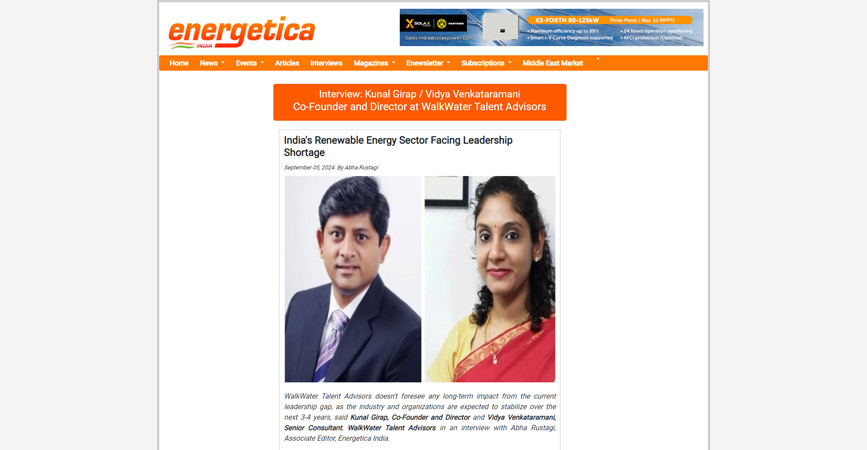
WalkWater Talent Advisors doesn’t foresee any long-term impact from the current leadership gap, as the industry and organizations are expected to stabilize over the next 3-4 years, said Kunal Girap, Co-Founder and Director and Vidya Venkataramani, Senior Consultant, WalkWater Talent Advisors in an interview with Abha Rustagi, Associate Editor, Energetica India.
Que: Could you provide a brief overview of the key findings from your study regarding the leadership gap in India’s renewable energy sector?
Ans: Since 2019, India’s renewable industry, especially in the solar and wind sectors, has seen rapid growth. Both the market and organizations have expanded exponentially. However, the talent pool within the industry hasn’t kept pace, leading to a situation where companies are often drawing from the same limited pool of talent, resulting in a noticeable shortage.
Over the past 3 years, we analysed the movement of CXO talent, focusing on roles like CEO, COO, CBDO, and CFO. We found that in the COO (Projects) role, about 54% of talent shifted within the renewable industry. Other roles like CEO, CBDO, and CFO also experienced significant movement, with an average of 35% of talent changing jobs.
The companies are increasingly seeking specialized talent and are competing for a limited pool of experienced leaders. The talent shortage is further aggravated by organizations primarily hiring through references, which restricts access to a wider pool of potential candidates and contributes to the ongoing scarcity of skilled professionals in the sector.
Additionally, organizations are not exploring talent from allied industries, and there’s a reluctance to experiment with new talent, further narrowing the available talent pool.
Que: How significant is this gap, and in what specific areas or roles is it most pronounced?
Ans: There is indeed a substantial talent demand-supply gap in the industry. We observe shortages in two key areas: leadership talent at the CXO level (including CEO, COO, and CBDO roles) and niche roles such as land acquisition, design engineering, and policy & regulatory expertise.
Que: What are the potential short-term and long-term impacts of this leadership gap on the sector’s growth and its ability to meet the 2030 and 2070 targets?
Ans: In the short term, this talent gap will hinder organizations’ growth, with many recalibrating their structures and go-to-market (GTM) strategies due to a lack of resources.
Organizations are focusing on strengthening their systems and processes, building a talent pipeline from the ground up, and creating a sustainable structure before committing to new projects. Land acquisition and grid connectivity are the top priorities for organizations in the immediate future.
Higher attrition rates and escalating retention costs are leading to a disproportionate increase in salaries, disrupting compensation parity at senior and leadership levels. This trend could become unsustainable for both candidates and companies, with candidates becoming overpriced and companies struggling to meet rising compensation demands.
We don’t foresee any long-term impact from the current leadership gap, as the industry and organizations are expected to stabilize over the next 3-4 years.
Que: Are there any emerging trends in talent migration that renewable energy companies should be aware of?
Ans: In the current scenario, we see limited talent migration from allied industries to the renewable industry.
Que: How does the current talent shortage risk the scaling of operations and achievement of environmental goals in the renewable energy sector?
Ans: The current talent shortage will impact the organisations’ growth, as we have noticed that organisations paucity of undertaking new projects at the same time recalibrating their organisation structure and GTM strategy.
Companies are focusing on strengthening systems and processes, building a talent pipeline from the ground up, and creating a sustainable organizational structure before committing to new initiatives.
Que: What role can government policy and industry collaboration play in mitigating this talent shortage?
Ans: While we cannot comment on government policy, industry collaboration can make a big difference in derisking the talent shortage by –
- Organisations can get into unspoken agreements of not hiring lateral talent from each other
- Strong advocacy of hiring talent from allied industry wherever possible
- Development of talent at grassroot level- hire from engineering and management colleges
Que: Looking ahead, how do you see the leadership landscape evolving in the renewable energy sector over the next decade?
Ans: The leadership landscape will settle down over the next 3- 5 years, with the organisations moving towards development of talent and as well as hiring of talent from allied industries. In an ideal scenario, we see the following alternate industry to be considered while hiring for critical roles.
Professionals with a background in construction or real estate could be well-suited for project management positions. Similarly, those experienced in petroleum and natural gas, power, or chemicals might excel in business development roles. Regulatory positions could be effectively filled by individuals from the automotive or power industries, while real estate professionals might be ideal for land acquisition roles. Lastly, design engineering positions could be effectively supported by candidates with experience in oil and gas or aerospace.
Source: Energetica








